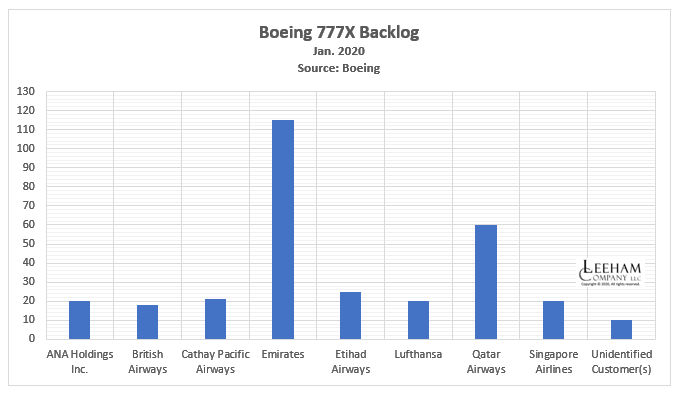Leeham News and Analysis
There's more to real news than a news release.
First flight of Boeing 777-9 today, weather-dependent
By Scott Hamilton
Jan. 24, 2020, © Leeham Co.: In a year filled with bad news, Boeing finally had something good to crow about.
The 777-9’s first flight is today.
It comes about a year late, due to design issues with the GE Aviation GE9X engine that powers the airplane.
And, as if this weren’t bad enough, when the engines were returned from GE, a hard landing damaged one of them.
Despite rainy and cloudy weather today at Paine Field in Everett (WA), where the 777 has been assembled since the program was launched in the early 1990s.
The 777-9 is scheduled to lift off at 10am PST, depending on the Seattle area’s lousy weather this week.
Slow sales
Sales of the X have been slow since its launch in November 2013. At its peak, there were 344 firm orders. Today, Boeing lists 308 firm orders, including 25 from Etihad Airways. The airline, however, said publicly several times it only plans to accept six 777Xs due to a major fleet restructuring. There are 32 orders for the 777-8, according to data seen by LNA. However, about 20 of these are believed to be subject to potential cancellation.
Emirates Airline is shown to have 115 orders, down from 150. Another handful are understood to be reconfirmable and are not listed on Boeing’s website.
There are 50 options and letters of intent for the X, according to a data base reviewed by LNA.
Entry into Service
Entry into service was planned for late 2019 or early 2020. It has slipped to 2021 due to the engine delays.
Boeing upped its sales game to keep the 777 production line going at a rate of 5/mo and a delivery rate of 3.5/mo. Boeing also sold a modest number of 777-300ERs and even one 777-200LR passenger model.
Based on these sales, the production bridge between the 777 Classic and the 777X looks solid.





@scott – I don’t quite grok graphic 2. just above it you say their are ~300 options or LOIs for the 777x but in the graphic, between the -8, -9 and x you only show ~130 options & LOIs total…
@billbo: It’s probably a data entry error, but I can’t check it out till Friday night as I am going to the event.
Saturday: Up up and away and flying out over that Cowtown to the West not over Puget Sound.
https://www.ainonline.com/aviation-news/air-transport/2020-01-25/boeing-777x-takes-first-flight
Good weather to the West, I understand 50 and sunny, it has its advantages over gloomy rainy windy Seattle!
Looks like flight patch return is to that gloomy lumber town.
you mean east, I assume…
Yep
they are headed into Boeing field now
https://www.boeing.com/commercial/777x/first-flight#/flight-tracker/3d
Looks like they found a nice spot about 40 miles West of Spokane and are doing turns. 15,000 feet or so and 250 mph.
https://flightaware.com/live/flight/BOE1/history/20200125/1800Z/KPAE/KBFI
This is a beautiful and informative article. I appreciate the effort that went into it.
In terms of some of the major emitters we have Iron and Steel 4%, Cement Production 5%, Aluminium, Non ferrous metals such as Aluminium 1.2%, Agricultural Soils 5.2% (I assume tillage) all greater than aviation.
The concentrated CO2 from cement calcination can be captured and combined with hydrogen from electrolysis to generate methane (synthetic natural gas) or jet fuel (PtL, Power to Liquids, via the fischer-tropsch reaction) or methanol. The micro reactors for methanol and methane small enough to be placed on site and the methane simply stored in gas pipelines. The same CO2 capture will work with Iron production but Iron can be smelted with hydrogen directly. Ammonia is produced by the Haber-Bosch process and is needed for fertilisers and mining explosives. The hydrogen needed comes from reforming natural gas but could just as easily be made from electrolysis.
Just about any process could be converted to one based on renewable electricity or a thermochemically driven process.
Here is the problem, the amount of energy required is enormous and I think we will need to turn back to nuclear. Attacking aviation is insanely pointless is ‘target fixation’
It’s worth pointing out that it was the intractability of many ‘environmentalists’ themselves that are responsible for shutting down the rollout of advanced nuclear reactors that would now be in a position to pretty much end the emissions crisis not only with cheap electricity, nuclear waste elimination via transmutation and thermochemical energy. The story of what happened to nuclear should be studied by aviation.
Aviation fuel can be produced from CO2 obtained from DAC (Direct Air Capture) and converted by PtL (Power to Liquids) with hydrogen at about 45%-55% efficiency. A 8000 ton plant per year plant is commissioning by Nordic Blue AS this year. An 321XLR can hold up to 35,000Litres. To generate this much fuel of energy value 8.5KWHr/L would require 15KWHr/Litre so about twenty(20) Vestas V90 windmills with an average power output of 1MW each will generate enough power to make this fuel per day. These windmills are about 1 million Euro installed in Europe. The electrolysis, reactor and DAC equipment would be less but we have to size for peak loads of at least 2MW/turbine. Hence about 40 million Euro will provide PtL for a 110 million Euro A321XLR. Apparently Europe’s wind resources are 22 times its energy consumption.
My own country of Australia has phenomenal wind and solar resources and exports of such PtL fuels make them exportable however I think we will come to hate wind turbines due to their visual pollution and impact on wildlife and they will always be expensive because of their intermittency.
While aviation is at 2.4% of emissions this percentage will rise when other industries decarbonised. For instance automobiles and even John Deere is producing an electric tractor. We will need to reduce fuel burn of aircraft by about 35% and fuel these aircraft with 50% fuel from PtL to meet IATA pledges of 50% industry reduction.
When you project that aviation emissions will rise, are you taking into account the newest engines coming online such as the GTF, Leap and the latest models for the wide body aircraft?
I think he means will rise as a percentage of the overall as the overall declines due to decarbonization.
I’ve obviously mis posted my post in the wrong article. Sorry to Scott.
Per seat emissions for aircraft are continuing to reduce at about 0.8%/year but air travel is increasing at 5%/year. However IATA members are using Carbon Offsetting Scheme for International Aviation (CORSIA), which was developed by ICAO( the UN body) to offsets the CO2 emissions aviation contributes. The pledge is 50% of 2005 emissions levels by 2050 with a absolute cap at 2020 levels irrespective of travel growth. It would be possible to manufacture a carbon neutral jet fuel indistinguishable from standard fossil fuel by PtL (Power to Liquids) but its much better to good works such as reafforestation or by helping other industries decarbonise. If you want to get rid of a billion tons of CO2 this is a much more cost effective way at this point. The worst way is a carbon tax as Governments can not show that they have spent this money on doing anything to reduce emissions and they will usually misuse it to appease their electors.
In an effort to keep on topic I’ve heard it claimed that Boeing claim that B777-9 are 15% more efficient per seat than A350 (presumably 900). Is it true?
And I thought I got off topic!
Yes. The separate Bjorns corner on efficiency for that is a new post today, should all be moved over
8000 tones per year from the Power to Liquids pilot plant ? At a prodigious use of power in a lignite coal powered area of Germany.
The main product is to generate subsidies and the present production rate I read about was way down from the claimed peak value ( it was so small I thought it might be typo error!)
Can anyone help me understand the concept of building / production line rate of 5 per month and a delivery rate of 3.5 per month?
Does this mean Boeing is stockpiling completed 7double7s at the factory?
Or is it a typo?
They are delivering the ‘old’ 777s while still in low rate production for the 777X – which will be going to flight test etc
Had me wondering as well, thanks.
You can think of it like 3/4 time in music – one note is silent but the beat is the same. The line moves every four (working) days, but when a 777-9 comes through there is a “blank” that allows one more cycle to build the new model. This is how one can build one version that takes longer to build, because it is high on the learning curve, while still making the existing model at a steady rate. This is a slight simplification, but this is the concept.
There are indeed a number of 777Xs at KPAE. Some are painted white, some are still in green.
Its 11.47 AM Seattle Time when Im reading this, so Im thinking all went well.
A lot of waiting at the end of runway with that link so deleted it
Im surprised at how high the engines are under the wing, the end of the nacelle is about level with the leading edge from the side view
This may be better from Boeing, webcast plus flight tracker
https://www.boeing.com/commercial/777x/first-flight
flight was cancelled due to high tailwinds
sigh
I noticed a long wire aerial connected to the top 777X tailfin, it had a what could be a small black cone at the end of the wire.
Cant be for transmitting data surely, or is it a form of lightning protection ?
NO its a cone shaped device to measure true airspeed, and used to make precision calibrations of airspeed for flight test, etc
It will be removed after all flight tests are complete
Saw that as well and had not seen it before.
Thanks for the explanation, looked pretty weird.
Correct, normal for Boeing at least.
Reason is to get pressure pickup away from the effect of the fuselage etc.
Ultimately standard pressure pickup points on fuselage will be vetted and calibrated, for regular use (with some corrections in manuals and computers).
It’s usually a hose – see below.
The B777-9 already looks a success before it’s flown in terms of orders, which already exceed A380 production. Despite the flight delays from engine issues and a door failing just short of its pressure test it’s problems seem small compared to what we saw with A380 and B787. The delays caused by the wiring looms on A380 were probably enough to turn A380 from money maker too money looser. Does anyone know what Boeing’s break even will be?
NO its a cone shaped device to measure true airspeed, and used to make precision calibrations of airspeed for flight test, etc
It will be removed after all flight tests are complete
” Despite the flight delays from engine issues and a door failing just short of its pressure test” it was NOT- repeat NOT a door failure had to do iwh buckling of the fuselage near the door due to a combination of pressure and wing loading and hold down forces/loads.
Yes, thank you Bubba. The expected mode of failure for the ultimate load test was buckling. and that is what happened. The rest of the damage was due to release of pressurization that began at the buckle.
William:
Far too early to call is a success. Those orders are iffy in some cases and can still shift. Its more a place holder right now than anything. The A350-1000 can be paired with its more economic twin (900) which has taken the -300ER spot that sold so well.
The 767-400 was not a success. Only Delta wanted it. And the investment was not that high.
It has the same issues as the A380 which were not technical, it was size. It may fit certain markets and airlines but its base is limited.
Order wise the wisdom is 250 in this size is to break even (zero out the investment not make money)
With Boeing its iffy as they kick the plane down the runway cost wise. The accounting block gives you some idea
That is all different from starting to return money when your production costs go below what your selling costs are.
For Boeing the difficult part is the outgoing 777-300ER was a cash cow and the 777X for some time will only sell for much much less money than it costs to make. Not a good place to be for a company which has no more cash reserves. Large orders mean large discounts too.
Boeing did the wrong approach for the last 5 years with its 777 production, soaking up orders with good prices to maintain the 10 per month production rate. Those airlines wont need to buy that sized plane for another 15-20 years.
The result will be the next plane after the 777X , the NMA will have a lot more of the 767 then even Boeing might have wanted a year ago. Aviation isnt the rag trade , but they still have to cut their cloth to their means.
We need to change that to attempted though I think they tried yesterday as well.
Have to watch counting your aircraft before they hatch.
First flight data in 3d- altitude numbers a bit flaky
https://www.boeing.com/commercial/777x/first-flight#/flight-tracker/3d
Mostly around 220 to 280 its highest speed seems to be most southward side of circle around mountain. For those not familiar- the mountain is Rainer- and it is almost a prime directive to get photos of Boeing planes with Mt In background- Used a t-33 ? chase plane I think.